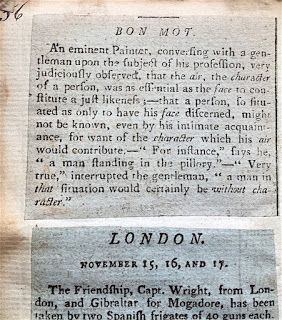More extracts from an anonymous ‘Review of Taverns , Inns, Coffee Houses and Genteel Eating Houses’ published in the New London Magazine, July and August 1788. The web has done part of the work by publishing the first part of this survey of eating places, which appeared in the June 1788 issue of The New London Magazine. Luckily, the second and third parts of this series remain offline. So here are some of the highlights of this witty and very politically incorrect survey of eateries in late Georgian London. See our earlier posting A Georgian Giles Coren for more..
Spread Eagle, Strand.
Long noted among the society of the humorous and intelligent. The rooms are here remarkably spacious. Indeed they are in stile. As to the bill of fare, it abounds with every article in the season, from a mutton chop to a bustard or John-dory. The wines are all pure and well flavoured. If there be any preferable to others, it is the sherry and the port. The master and waiters are as civil and patient at four in the morning as at eight in the evening; and the prices of the various articles are very moderate.
Pitch-cock eels are here in the utmost perfection. Being in the vicinity of the palace, it is ever frequented in the summer months, by the great, the dissipated and the inquisitive. The apartments are airy, the bill of fare is rich and diversified.
The wines are all excellent. If the bill appears stretched sometimes, strangers cannot much repine, as they have always the best of everything for their money, and likewise the utmost alacrity of attention. The guests would rather pay a guinea at the Toy, from experience, that fifteen shillings for the same fare any where contigious.1)
August 1788
Windsor Castle, Richmond.
Long has this house been in estimation. Rigby, who often formerly used to bait here, en tete a tete, used to say “ that further up you may fare worse! “ . The apartments are all spacious, and the view from behind a most luxurious landscape! Good eels, good fowls, and good venison, are found here. The various courses are all served up in style, and there is not a wine but what is of the highest flavour, and best quality. The stables too are excellent in equestrian accommodation; and that is no secondary consideration with a man of feeling, who feeds his horse himself, while the cuisineur is preparing his own feed. The charge is by no means extortionate, and there is as grateful a fair hair’d curtsey at the bar to be had for a shilling as for a guinea. In the left front parlour is a room befitting even Middleton himself. It was lined by India, at least in painting—the panels were formed for the room, and then sent out for Asiatic gilding!





